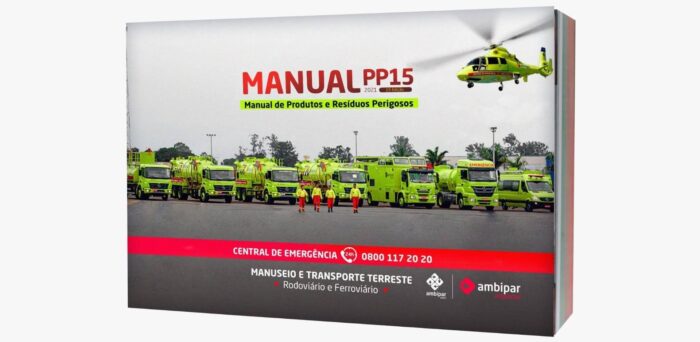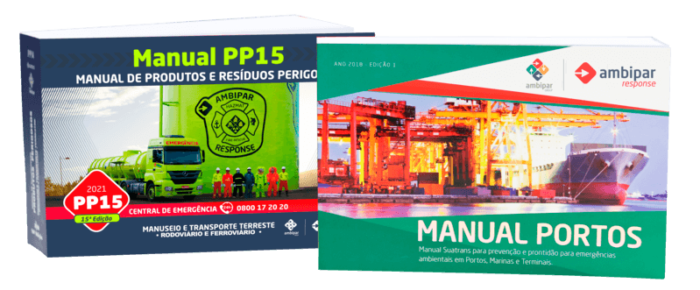
By Equipe de Redação
Posted in May 20, 2021

In Brazil, the transportation of cargo classified as dangerous, whether by road or rail, follows strict rules established by a regulation that has very technical specifications and ordinances and standards determined by different agencies. They deal, for example, with environmental and traffic legislation, technical standards, and include inspections, such as those carried out by the Federal Police. The objective is, ultimately, to avoid accidents that may cause some kind of damage to the environment and preserve people’s lives.
With so many specifications, it is difficult – even for the most experienced professionals – to know if each trip is in accordance with what the rules stipulate. In order to have an idea of the complexity when talking about risk in cargo transportation, even the transportation of cotton needs to follow the rules provided for in this regulation, due to its risk characteristics of spontaneous combustion during displacement.
To support companies, the transport sector, the government and inspection agents, Ambipar, a multinational with operations in several segments in which it offers services and products aimed at environmental management, provides the (Self-Protection manual for Handling and Transporting Dangerous Products (DP), a publication updated in line with said legislation.
This year it reaches its 15th edition, hence the name PP15, and it has become a national reference in terms of legislation on dangerous products in the Country and regulations that directly and indirectly affect road and rail modes.
15th National Seminar on Handling and Transportation of Hazardous Products and Waste
Ambipar is preparing the 15th National Seminar on Handling and Transport of Hazardous Products and Waste. The event brings together the Country’s leading experts in legislation and environmental emergencies from public agencies to discuss everything about the sector and launch the PP15.
The program includes a chat about updating the legislation on the transport of dangerous products; inspection of the transport of dangerous products by road; accidents in the transport of dangerous products; performance and expectations of environmental agencies in emergencies; and action plan and operations to respond to environmental emergencies.
During the lectures, 30 new PP15 manuals will be raffled for the public. The event is completely free, but has limited spaces. Interested parties must register through the link https://manualpp15.com.br/. All participants will be certified.
PP15 in digital version
The most recent edition of the manual has just been made available and, in the coming months, it will gain a digital version, in the form of an application, says Dennys Spencer, technical director of Ambipar. “The publication proposes to bring the legislation in a complete and updated way”, summarizes Spencer.

As it is a complex and extensive content, with many regulations and ordinances, the manual is divided into chapters dealing with legislation on the transport of dangerous products, traffic legislation, road transportation legislation, railway transportation legislation, environmental legislation, product legislation controlled by the Federal Police and the Army, in addition to the requirements of Inmetro and the Associação Brasileira de Normas Técnicas (ABNT)
The activity of transporting dangerous products has an interface with other areas, hence the need for the manual, explains the director of Ambipar. The publication serves professionals and technicians who work directly in the area – transporters, industry in general, corporate customers who receive the goods, companies specialized in responding to emergencies with dangerous products and public bodies responsible for inspection.
Today, for example, the manual is used in training carried out by inspection bodies, such as the State and municipal Highway Police and Civil Defense.
The content is so complete that the manual has 1,057 pages – 517 of them exclusively on the regulation of transport of dangerous products. The rules range from signage, by means of a sign, which must be attached to the truck to indicate, by means of an internationally standardized numbering, the risk class and the type of product, to the indication of the specific suit and types of clothing. personal protective equipment (PPE) that the truck driver needs to have in the cab.
“There is a rule even for the dimension of the plate that is fixed on the truck with the numbering that indicates the type of product. If it is out of the standard, for example, the vehicle can be seized until the symbology is regularized ”, explains the Ambipar executive.
The theme of cargo transportation is very sensitive for professionals and companies in the area, for inspection bodies and for society. “The purpose of regulation in this area is to protect people, the environment and public assets from the risks that these products can cause when, in an accident, exposure occurs in an uncontrolled way”, summarizes Spencer.
The numbers confirm the concern that one should have with the subject. According to data released by the Environmental Company of the State of São Paulo (Cetesb) and available for consultation on its website, on average, in the state of São Paulo alone, there are about 470 accidents involving dangerous products per year. That is, more than one per day. When only road accidents are taken into account, we have, on average, a total of 270 accidents. In other words, approximately 60% of the total occurrences with dangerous products registered by the environmental agency of the state of São Paulo occur on highways.
“This type of technical knowledge that is present in the law should be more widespread. People should have contact with the topic from school so that, in the future, they know what to do when they encounter a road or rail emergency, ”says Spencer. For the specialist, putting in place correct evacuation actions can mean the difference between the preservation of people’s lives and patrimony.
In this context, a point of attention is the environment, since accidents with the transport of products, especially liquids, can cause severe contamination in the soil and rivers. These are accidents that can take decades to neutralize their effects or, in many cases, just minimize them, with damage not only to the environment, but to the local communities that use these resources as a means of subsistence or economic activity.
As Spencer points out, currently, companies are increasingly aware of the impacts that can be caused by an accident in the association of the brand with a negative image due to the damage generated. Society is increasingly demanding from companies about their responsibilities in relation to the environmental impacts caused as a result of accidents related to their processes.
“The impact can be huge. After all, we know how relevant environmental issues are to people’s lives. Today, the population reacts very immediately when the company fails to act on a topic like this. Therefore, it is necessary to be prepared so that accidents do not happen. If they happen, the response will be immediate to cause the least possible damage ”, warns the director of Ambipar.


Our business analysts are ready to help your company with the best environment solutions.